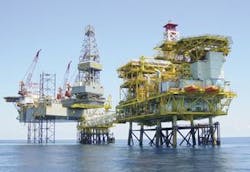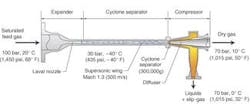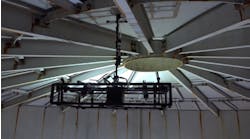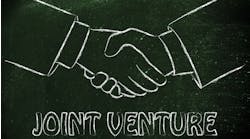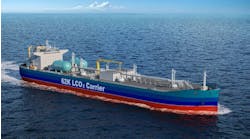The Twister supersonic gas separation system recently began its first commercial application. Success on the Shell Malaysia B-11 P-A offshore development may bode well for the future subsea application of this system.
Twister was introduced at OTC three years ago. Since then, it has seen various onshore applications, but only in pilot programs. The Malaysia installation is considered important by the operator, Shell Malaysia, and Twister because it is the first commercial offshore use of this gas dehydration system. Shell calls this a landmark, because to use Twister properly, an operator has to design its production facilities around the system. This means if Twister fails, it will require a redesign of the topsides to convert to a traditional gas separation system. Because such a major up-front commitment is involved, it took a lot of time and effort to convince Shell that the Twister technology was mature enough for offshore application.
Twister combines expansion, gas/liquid separation, and recompression into one compact tube. The system uses a specially designed Laval nozzle to transform pressure into kinetic energy. The Laval nozzle expands the saturated feed gas to supersonic velocity, which results in a low temperature and a low pressure. This low temperature forms a mist of water and hydrocarbons. A wing, placed in the supersonic flow, throws the mist into a high-vorticity swirl (up to 300,000 g) centrifuging the droplets to the wall. The liquids are thus separated from the gas. Both flow streams are then slowed using diffusers, recovering 65-80% of the original pressure. The liquid stream contains slip gas, water, and condensate. This phase moves on to a secondary separator to be processed.
This process has two key advantages over conventional separation methods. It requires no moving parts and no chemicals. It is also smaller and lighter than a conventional separation system.
null
In the case of B-11, 10 operational tubes were used. Because Twister is a fixed flow device, an individual tube has only +/- 10% turndown flexibility. The Laval nozzle converts the incoming production stream to the exact sonic velocity needed for separation. This means there is no need for flow control devices. Throughput restriction for the system is a function of the diameter of the throat of the Laval nozzle. The system uses the natural energy of the production stream and recovers 65-80% of its original pressure upon exiting the tube, similar to conventional technologies. Because the residence time of the gas in the Twister tube is extremely short, hydrates don't have time to form. Hence, there is no need for chemicals and supporting regeneration facilities, with its emissions to the environment.
Once the liquid phase exits the Twister tube, it travels to a secondary separator. This flow is heated to avoid hydrate formation. Then, heat is applied to the secondary separator vessel to break out the oil, water, and gas. Because the production gas is moving at supersonic speeds through the Twister tubes, sand control is critical to limit erosion problems. Incoming production first moves through an inlet separator to knock out the solids. This is a conventional cyclonic separator that removes solid particles larger than 10-20 microns.
The first Twister field trial was conducted in the Netherlands in 1998. Since then, Twister has been subjected to four field trials, three in Norway and one in Nigeria. All of these were onshore. Shell Malaysia B-11 P-A was its first offshore application. Beyond the pilot projects, Shell wanted the system to undergo a number of qualification tests conducted onshore, before approving it for use offshore.
One of these test units at the NAM Leermens facility in the Groningen gas field was designed to mimic the offshore conditions on the B-11 field. "We used these to convince them the technology was mature," Job Brouwer, Twister Engineering manager, said.
This onshore plant was also used as a training simulator for the personnel who would be working offshore Malaysia.
It was important for the Twister system to be incorporated into the early planning stages of the B-11 platform. Hugh Epsom, Twister sales director, said many of the advantages of the system involve capex savings. He gives the example of a platform that would require personnel to operate using conventional separation technology. Because Twister requires little maintenance and no chemicals, it may be possible for this platform to be unmanned, using the new system. Hence, a separate living quarters platform could be avoided, saving on the structure design, steel weight, topsides equipment, and personnel costs. It is also safer to avoid sending personnel offshore. In fact, one long-term operator goal is to eliminate, as much as possible, personnel from offshore platforms.
There are other areas of savings, Epsom said. Because the Twister is so effective in cleaning the produced gas on the platforms, using it can allow a single-phase export line. Again, this is an advantage that must be addressed in the design phase to be beneficial. Epsom said Shell brought Twister in early in the process when designing the production solution for B-11. By the time Shell placed its order for the Twister, Epsom said, the vendor had already confirmed it could meet the specifications of the B-11 project. Because this project is in Malaysia, the requirements for dry gas were not as stringent as they would be in another region such as the North Sea or US Gulf of Mexico. The seabed temperatures in this field are relatively warm, raising the dew point for the export line. This gave the designers of the Twister unit a wider margin of error than they would have in colder, areas where the water is deeper. Nevertheless, Epsom said the units installed on B-11 could meet the higher thresholds of North Sea applications.
null
Subsea separation
With the B-11 offshore system up and running since late 2003, Twister is moving closer to the ultimate goal of installing this technology subsea. Epsom said that most of the components are in place. The only critical challenge remaining is to marinize the components and design instrumentation that would allow remote operation of the system. The Twister design itself would need to be very robust, Epsom said, to operate continuously subsea. There are also questions concerning wet-matable connectors, transformers and pipeline connections that would be needed for a subsea application.
"The big challenge will be marinizing all of these components," he said.
In the meantime, the next applications offshore may be on hub facilities, Epsom said. The company is looking now at such facilities in Southeast Asia, West Africa, and Mexico. He said there are some interesting applications of the system in Nigeria. New regulations in that country have made flaring of gas illegal. One of Twister's advantages in remote areas is that it doesn't require chemicals – both an environmental and logistics advantage. It also means the system can operate on unmanned facilities.
